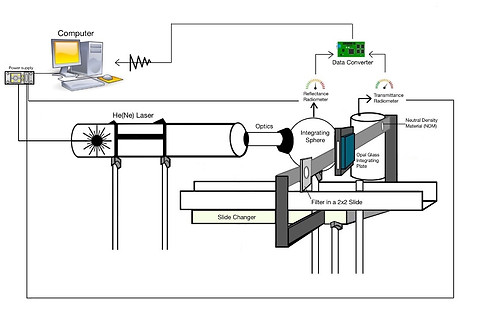Sampling Instruments
Air-sampling instruments are supplied by
Filter Sampling Station

A second generation air sampling station which uses a high-precision dynamic cyclone inlet to collect both PM2.5 and PM10 on separate filters within a single cartridge.
Filters samples for 9 day periods, with 6 filters collecting PM2.5 and 1 filter collecting PM10 along with one travelling blank. A cartridge thus samples autonomously for 54 days before needing to be replaced.
Integrating Nephelometer

This 3-wavelength integrating nephelometer measures aerosol scattering, RH% and temperature every 15 seconds.
A clean-air reference system allows for the regular base-line correction while in the field.
Like the sampling stations, a cyclone inlet allows for a dynamic size cut which lets optical properties of the PM2.5 and PM10 fractions to be measured.
Lab Equipment
At Washington University's Center for Aerosol Science and Engineering
Automated Filter Weighing

-
Weighing is performed in a Darwin-Chambers environment-controlled room
-
Teflon filters are weighed using Mettler Toledo's automated filter weighing and data processing system
-
System is EPA 40 CFR 1065; EPA 40 CFR 1066; Euro 4, Euro 5, Euro 6 compliant
-
Filters are loaded into silos, and selected in sequence. The filter carrier is picked up by a mechanical arm and delivered to the balance
-
Static is minimized for weighing by a built in Faraday cage which surrounds the balance platform
-
Weights are automatically recorded
-
Weighing is done at controlled temperature (21-23 deg C) and humidity (38-40 % RH)

Ion Chromatography
-
Both anions (Nitrate, Sulfate, Chloride) and cations (Magnesium, Calcium, Potassium, Sodium, Ammonium) concentrations are quantitatively determined
-
Separate separatory columns in individual instruments are used to analyze anions and cations on the Thermo Dionex systems


X-Ray Fluorescence

-
Trace metal content is quantified with the Panalytical Epsilon 4 X-Ray Fluorescence spectrometer

-
Sartorius Ultra-Fine Balance is accurate to ± 0.1 μg and is paired with an anti-static blower.
-
Filters are weighed in a ISO-4 standard clean room. Measurements are taken at controlled temperature (20-30 deg C) and humidity (30-40 % RH)
Effective Black Carbon



-
Effective Black Carbon (EBC) is measured via reflectance using a Diffusion Systems Smoke Stain Reflectometer (SSR)
-
Total EBC is logarithmically dependant on the reflectance R. EBC is thus quantified using an empirical conversion constant
Inductively-Coupled Plasma Mass Spectrometry
(Water Studies Lab)


-
Trace elements are extracted from Teflon filters using an HNO3 acid digestion on a heating block
-
Elemental concentration are detectable down to 0.1 ng/m3 and up to 1000 ng/m3
-
Metals of natural origin (Na, Mg, Mn, Al, Ti, Ba) and also elements commonly associated with anthropogenic activity (K, V, Cr, Fe, Zn, As, Ni, Pb) are all quantified
Additional analysis is currently performed by our partners
FTIR and HIPS by Ann Dillner's group at UC Davis
Fourier Transform Infrared Spectroscopy (FTIR)

-
FTIR spectra of teflon filter samples are used to measure organic carbon (OC), elemental carbon (EC) and organic functional groups such asaliphatic CH, carboxylic acids carboxylates and alcohols
-
A Bruker Tensor II FTIR with a liquid nitrogen cooled detector provides consistent measurements with low detection limits
-
This is a non-destructive technique, enabling further measurements to be performed on the same filters prior to the destructive final steps of IC and ICP-MS.
Hybrid Integrating Plate/Sphere (HIPS)
-
From reflectance and transmittance values obtained through the HIPS technique (technical schematic shown at right) we are able to infer information about black carbon content of filter deposits
-
Filters are mounted on a 2 x 2 inch slide plate facing away from the incident light of the HeNe laser with a wavelength of 632 nm


